#i can live with snakes i can live with lizards i can live with birds
Text
whyyyyy are dog people so obsessed with their pet taking a shit...
#im. Confused. bc seriously why! what is it!#we have had this dog for One Full Day and the amount of times#that my stepdad has felt the need to regale me with her using the bathroom on a walk#is. well frankly its Insufferable and i Want It To Stop#like respectfully! affectionately! I Do Not Care! Hush! Cease! Good For Her! None Of My Business!#i am learning so quickly that im solidly a cat person#i do not enjoy having a Wet Beast! dogs are fine when they're not in my house!#me and my cats are like... living in my room now#i almost said Our room. well. that wouldnt be wrong at this point#absolutely unprompted#i can live with snakes i can live with lizards i can live with birds#but dogs? theyre just so much... too much...#sensory nightmares! big and loud and smelly and slobbery and their fur feels weird and theyre so Pushy-#i could handle it if it was a uh... a Sensible dog!#but this is a golden retriever mixed with a samoyed i believe!#that is not a sensible dog thats a 'i will force myself into your personal space' dog#sorry. sorry. im just not very happy with this development lmao#but its not my house not my decision and my stepdad needed an affectionate furry friend#he's happy! good! i can keep my mouth shut about my deep displeasure!#cats are so neat and clean and just sweet little packages of delight... i need to be in a room full of kittens STAT
44 notes
·
View notes
Text

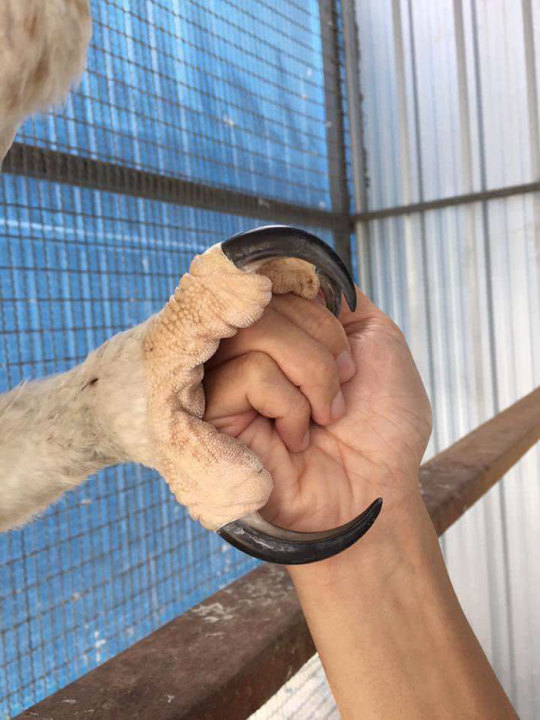
Harpy eagle, the largest eagle in the world looks like a person in a bird costume, but judging by the size of his talons, I wouldn't want to make fun of him face to face. They live primarily in the upper canopy layer of tropical lowland forest and are considered "endangered species" in Central America due to the rapid decline in their numbers as a result of deforestation. Less than 50,000 of them can be seen over the world.
Harpy eagles have a hearty appetite and enjoy munching on a variety of monkeys, tree porcupines, sloths, coatis, birds, snakes, and lizards.
#harpy eagle#birds#birds of prey#largest birds#largest eagle#endangered species#goofy looking birds#huge talons#no handshake please#scary claws#wildlife#wild animals#nature#wow#bird lovers#birdwatching#birding
670 notes
·
View notes
Text
Well, um, it finally happened. I genuinely cannot believe that the first death threats I've gotten while running this blog have been over cladistics of all things! I just wanted to pop in, clarify my position, and say, uh, don't do that.
So, the nasty asks I got were concerned with how I defend the breaking of Squamata into three groups (lizards, snakes, and amphisbaenians). I cannot stress enough that I fall into the majority of herpetologists when I defend this. This is something that is taken for granted among herpetologists at large - we're not a monolith but that's just the state of herp academia right now. This isn't me "denying modern science," it's me using the terminology that my profession uses.
I personally find that this breakup is more useful than the "everything is lizards" model for a few key reasons. It's good for highlighting differences and commonalities between groups and it's good for teaching herpetology to newcomers. Most importantly, on a practical level, it's the easiest way to for us to discuss Squamata in our daily lives and it eastablishes a very clear terminology for academic writing in our field.
Are all squamates technically lizards? Sure, we can define the entire order as lizards if we wanted to. But I feel that's similar to defining birds as reptiles - it's technically accurate, but on a practical level for those of us working with living animals right now, it may be accurate but at the end of the day you're not going to ask me to know about birds and I'm not going to ask an ornithologist to know about snakes. There are just some differences that we need to account for.
When it comes to those of us who discuss evolution on a broad picture compared those of us who work with living animals as a profession, there's just going to be a difference in terminology sometimes. If we discuss evolution broadly, then yeah, I can see the usefulness in not dividing Squamata. But on a practical, small-scale level, dividing makes it easier for us to discuss these groups in the detail we need to. I cannot stress enough, again, that this is just the accepted terminology that professional herpetoligists use right now. Cladistics isn't something to get super worked up about, phylogeny is a tool that different academics can use in different ways to suit our professions, and not like an indicator of education quality or intelligence level or whatever.
Right, that out of the way...I know most of my readers are amazing and wonderful and I love you all, and I'm sure it was just one person I've already blocked sending nasty asks, but, like...don't do that. I don't know what kind of reactions asks like that are hoping for, but I'm just going to block senders and delete all of them, no exceptions.
Sorry for the buzzkill. Back to our regularly scheduled content.
577 notes
·
View notes
Text
I see a lot of content here in the solarpunk community about the importance of re-wilding, of re-introducing biodiversity and turning our garden's into little sanctuaries, but this has always felt super inaccessible to me. I have always lived in rental properties that have little to no outdoor space, need to be regularly mowed for inspections, and where I am not allowed to make any major changes to the garden.

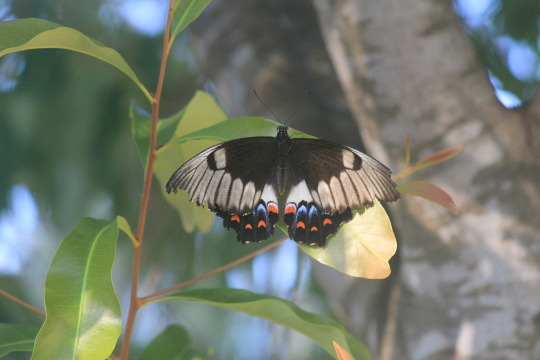
Recently I moved into a tiny granny flat. The yard is about a metre and a half of grass in a circle around the house, and a metre of grass either side of my concrete driveway. When I first got the inspection report for it, the real estate described the yard as "mostly weeds." This time I thought, fuck it. I only have inspections once every three months, which gives me plenty of time to let it grow without anyone noticing. Plus I had the insurance that with the lawn being "mostly weeds" the real estate wouldn't notice the difference. Let see if letting it grow actually makes a difference to the eco-system around me.


I invested in a push mower, to cut down the grass without doing much to the "weeds", and then after my first inspection I just let it grow. My hopes were not high. My space is absolutely tiny, and most of the wild flowers growing in my yard mostly invasive species for Australia. I had no idea if it would make any difference at all.
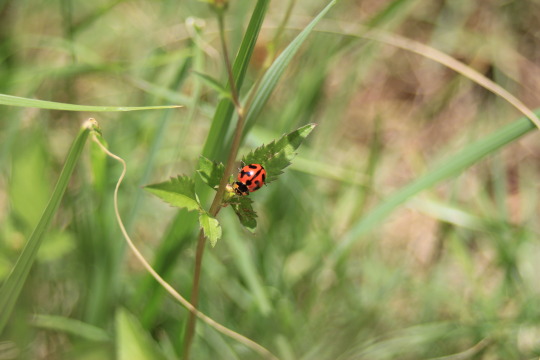
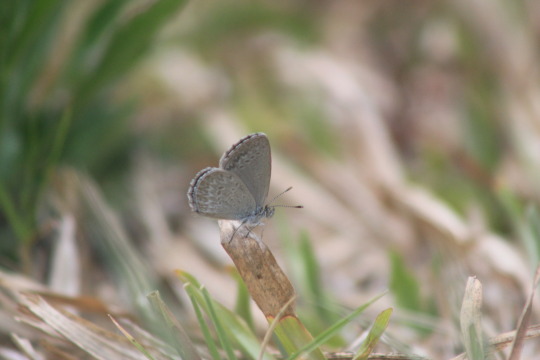
Its been an uncharacteristically rainy spring here, so the flowers all sprung up far far more quickly than I thought they would. Only two weeks after the mow there were dandelions as high as my knee. With the wildflowers came the bees, and the butterflies, and then after that came the ladybugs, the dragonflies, the lizards, spiders and birds. The photos above are only a tiny fraction of what the garden has on offer, and those are only the photos from this week.
When I first moved in, I didn't used to see anything in the well mowed lawn but ants. Its only been about a month and a half since I mowed it, but with all the rain we've had recently its sprung to life far far more quickly than I'd hoped. With such a teeny tiny lawn in the middle of the suburbs I really didn't expect to see a difference in biodiversity. How much difference can such a tiny little patch of flowers actually make? It turns out a lot.
I'll be devastated when I next have to mow it all down in another 6 weeks, but with the risk of snakes here, its probably for the best. It honestly been so lovely to walk down my driveway in the morning and be circled by all the butterflies. Its made my day every morning.
I hope I've convinced anyone else who also has a tiny space and has been considering letting it grow out to give it a go. You don't need to have a huge garden or be able to plant all native species in order to make a difference. Although these things are great, making due with what you have is the best first step.
#solarpunk#permaculture#biodiversity#gardening#rewilding#ecopunk#Also if any of you have any photos from your own garden of how your own rewilding projects are going please share with me!
343 notes
·
View notes
Note
So maybe this isn't your exact field since I see you curate dead things and not alive things. Regardless do you know of any common frog pets that you wouldn't condone for pets that people might not know about? For example. You can buy an iguana but an iguanas habitat size and environmental needs often lead to them being in, intentional or not, abusive households for them. I know lots of birds, snakes, and lizards that are like this but I haven't heard much about frogs. Are there any you can buy but probably shouldn't for some or several reasons? Is it ok to keep poisonous tropical rainforest frogs for example? I see some as pets and it seems iffy to me.
This may be an unpopular opinion, but basically I am of the opinion that most people who keep frogs as pets should not be doing so. They require specific environmental conditions that are not always easy to maintain without relatively major investment of both money and time. They also need almost constant access to food (especially dendrobatids), but that diet also needs to be balanced. It is common to see Ranoidea caerulea (White's tree frogs) that are extremely overweight, which is reflective of poor diets. No frogs should be regularly held, but many people take theirs own on a regular basis.
All-told, there are no frogs I know of that I would consider appropriate for beginner animal keepers. Reptiles are often much more forgiving in this regard. But it is also important to remember that no animals should be testers or trainingwheels, especially ones that are as long-lived as some of these. They are a huge commitment. I think that gets forgotten a lot of the time. Tbh, I myself have been guilty of that in the past. But we should work to do the best we can for the animals in our care. And to know our own limitations and abilities, and not acquire animals we cannot care for appropriately.
265 notes
·
View notes
Text
‼️‼️THE GRAMPA SQUAD COMIC IS DONE‼️‼️





Ok so, wee explanation + headcannons under the cut.
Ok so assuming you've stuck around for my insane ramblings, heres the gist:
This comic is very much inspired by Factual Fantasy's Comics about Marsh, Natquick, and Calico Jack. And while my personal head cannon does share in the idea of the group working together- I thought it would be hilariously fun to include Inkling, and tbh it focuses more on him than the others anyway.
In the show, inkling doesn't really get out much. There are really only a few episodes where he has a significant role, and even less when he actually participates in missions outside of *insert knowledgeable insight*.
I believe this is for 2 reasons:
He just prefers the comfortable vibe of his library. The book-worm role fits his personality well - enjoying studying or cataloging species alongside Shellington - and he likes spending time with the Vegimals.
His Mobility issues. While he can very easily traverse the watery environments in the base show- in a&b, he doesn't really show much interest in exploring the land until he's told an old friend was the one in need of help. He has the ability, its just difficult- and he knows his limitations.
Inkling has his hover chair, that allows him to move around the octopod relatively easily. However - in the Min episode - they make it a point that he cant take it with him on land, or use it over rough terrain.
My version of Inkling uses an actual wheelchair, so I thought it'd be a neat idea that after that adventure- he'd want to try joining missions more often. And to deal with said mobility issues and limitations- say they got specialized tires for his wheelchair- so he could go join up on land missions more often.
After going on a few more missions with the other Octonauts, he hears about Octoagents Calico Jack, and Professor Natquick joining up with Ranger Marsh to help out in the Everglades- you best bet he jumped at the opportunity to tag along. Think of all the species he could ad to his personal catalogue. They might even discover a few new ones! Leaving the Octopod for so long after being basically the one constant to the place was a bit scary sure - and the other Octonauts were certainly emotional ab him leaving (especially Barnacles) - but maybe a change of scenery would do him good.
Sooo He does that! Professor Inkling meets up with the others on a dock near Marsh's Ranger station and get to work! One of the coolest things they did was collecting egg samples and catching an adult specimen of a newly discovered trapdoor spider! the Pine Rockland Trapdoor. Marsh Has a nursery where he cares for tons of snakes, lizards, insects and birds to make sure they have the best chance for survival. Thats where these eggs are going- to hatch in safety and then be released back into the ecosystem. On top of that, they take samples of the adults venom for study, and inkling is sure to make a detailed report of the arachnid in his many journals brought along with him!
As you may expect, Kwazzi takes after his grandad in his fear of spiders. Jack has seen worse, but It doesnt make it any easier to be close to them. Natquick on the other hand- In all his time in the arctic hes never seen anything as freaky as a spider bigger than a quarter.
Aaand that's it! I'm hoping to do some more comics with the lads in the future, although probably not as detailed as this one. It took more than 2 weeks- please.
Also, I find it kinda goofy that the panels get more detailed as you go along. Thats what happens when the first and last panel were made almost a month apart from each other. 💚
Also also- yes I did do actual research for the animals in the last comic. It was going to be a funnel web spider they're researching, but then I looked it up and found out Funnelwebs don't live in the Everglades. :']
359 notes
·
View notes
Text
i am so, so tempted to develop a dark magical carnival or circus au with some of the genshin cast… not x reader necessarily, although you can imagine it that way if you want, but rather headcanons and short descriptions about their roles as performers in slightly uncanny acts.
for example, scaramouche is a marionette without a puppeteer; he’s made half of wood and moves jerkily like a puppet on strings, but nobody controls him.
there’s also mona, the illusionist who conjures up images from water and creates reflections and mirrors that make it seem like she’s everywhere and nowhere at once, disappearing from one end of the tent one second and appearing on the other side the next.
or you could go and see xiao’s act as leaps blindfolded across a tightrope, dodging flaming torches and balancing on his staff all the way. he never falls off the tightrope. ever. some say he has bird claws for feet, and hidden wings.
albedo is an option, too, turning caged doves into basilisks into harmless lizards, and even splitting himself into two copies of himself who work and talk and move in unison.
you can see baizhu, the contortionist who moves like a snake and has a forked tongue and slit pupils, whose assistant herself is a little frankenstein, who needs stitching up now and again so she doesn’t fall apart at the seams.
candace is known for hypnotism and psychosis, with a voice like smooth velvet. she sends people to sleep with her blue eye and reads their minds, sometimes even futures, with her gold eye, but never tells anyone just how much she’s seen.
they also have kokomi, the mermaid, who swims in a large, dark tank overgrown with algae, webbed fingers pressing against the glass to stare at passersby. sometimes she does tricks, like a dolphin, and is fed live fish as a reward.
yunjin sings and sends her audience into a trance. nilou is on the silks, twirling through the air like a sycamore seed. itto is a strongman with the horns of a demon, and has been said to ever shatter diamond. klee escapes a little cage before the bomb in there with her detonates. kazuha plays music on leaves and throws them like knives, pinning audience members to a board by the threads of their clothes. barbara mimes, and climbs invisible ladders high into the air. they say her voice was stolen from her.
yae miko organises the events and runs the carnival. yelan makes sure those who visit neither steal nor smuggle; those who do are never seen again. sometimes strange howls can be heard from cyno’s tent in the dark hours before dawn, after all the performances are over.
so come over, buy a ticket! visit the carnival tonight, because you won’t see the likes of it again! (we do not take responsibility for any missing persons or injuries that occur throughout the performances.)
#can you tell that i’m a fan of ‘dark (insert some magical thing)’ aesthetics#fairytales… circuses… carnivals…#i’m basically in love with uncanny fantasy#i have so many ideas for this circus oh my god#genshin impact x reader#scaramouche x reader#mona x reader#xiao x reader#albedo x reader#baizhu x reader#candace x reader#kokomi x reader#and so forth#this is not me abandoning my dark sorcerer au so don’t worry#i’m working on chapter four and it should be done… relatively soon#and this wouldn’t be a continuous series; rather a collection of scenes/descriptions and whatnot about each act and the general carnival
572 notes
·
View notes
Text
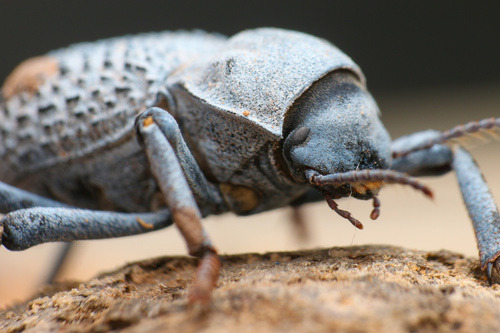
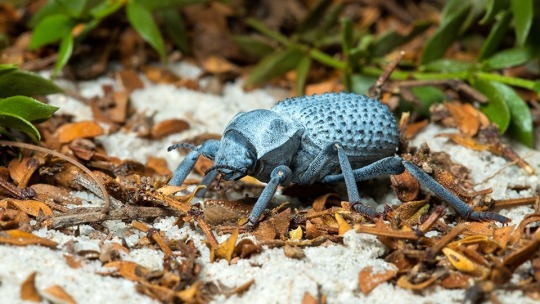
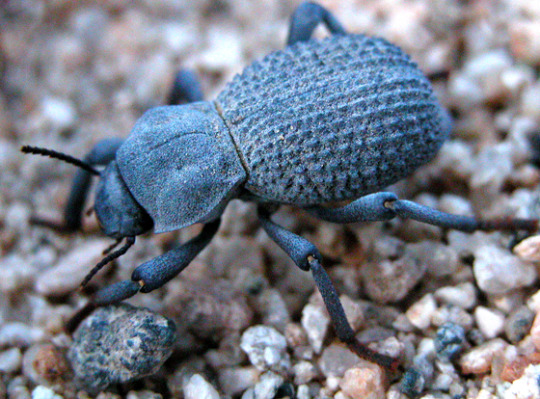
RIP: The Blue Death-Feigning Beetle
Also known as the desert ironclad beetle, the blue death-feigning beetle (Asbolus verrucosus) is a species of darkling beetle native to the Mojave and Sonoran deserts of the southwestern United States and Northern Mexico. Within this environment, the desert ironclad beetle can often be found near vegetation like sagebrush or palo verde trees, or hiding under fallen logs or rocks. However, it's not uncommon to spot it trundling along out in the open.
While the blue death-feigning beetle's coloring might make it stand out against the dull desert background, it actually serves a useful purpose. The color is a result of a heavy coating of wax that covers the beetle's body; this wax helps reduce evaporation and preserves precious moisture. It also helps that A. verrucosus is a small species, no more than 8–21 mm (0.71–0.83 in), and as they are most active at dawn and dusk they are easy to overlook. Males and females are virtually identical; the most reliable way to tell the difference is by the antennae, as males have long bristles on the underside while females don't.
Despite their small size-- or perhaps because of it-- desert ironclad beetles are a popular snack for many other desert dwellers, including lizards, snakes, birds, small rodents, and foxes. When threatened, blue death-feinging beetles live up to their name: they drop to the ground, roll onto their backs and play dead. This state can last anywhere from a few seconds to 45 minutes. Once the predator is gone, they are able to use their long legs to easily right themselves and continue with their business. Like most other darkling beetles, this species is an omnivorous scavenger, feeding on dead insects, fruits, lichen, and other plant matter.
The desert ironclad beetle can mate year round, given optimal conditions such as good rainfall and plenty to eat, but they're most active during the summer months. Once a male encounters a female, he courts her by 'tickling' her back with his antennae. If she is receptive, the two mate and then part ways. The female digs a burrow and lays a clutch of eggs in moist soil, where they take 2-3 weeks to hatch. Once larvae emerge, they immedietly begin to seek out organic matter to feed on. Over the next several weeks, they can grow from 2-3 mm (0.07-0.11 in) to 50 mm (2 in)! When they get big enough the larvae burrow into rotting wood and pupate for about a month before emerging as adults. Individuals can go on to live for up to 10 years in the wild.
Conservation status: The IUCN has not evaluated the blue death-feigning beetle, but it's believed that populations are currently stable. The species' primary threat is collection for the pet trade.
If you like what I do, consider leaving a tip or buying me a ko-fi!
Photos
Mason S. via iNaturalist
Bruce D. Taubert
Hartmut Wisch
#blue death-feigning beetle#desert ironclad beetle#Coleoptera#Tenebrionidae#darkling beetles#beetles#insects#arthropods#desert arthropods#north america#southern north america#central america#animal facts#biology#zoology
145 notes
·
View notes
Text
Here’s some random ideas about pets.
Mihawk: Owns a dog. Not just any dog, however, but a goofy Golden Retriever who doesn’t have a mean impulse in his body and almost certainly has no brain cells either.
Law: Also owns a dog. In his case, it’s a cute little puppy that came up to him on the street with the tail wagging and these floppy ears and a face that said “Henlo! We frens?!” Cue the adoption and Law’s heart growing a few sizes.
Akainu: Owns a dog of unknown gender that virulently loathes everyone who isn’t him. Recruits have learned to dread the sound of its toenails clicking. There are many who fantasize about throwing it overboard, even animal lovers.
Kid: The world’s worst-tempered cat has latched on to him. The only people it (no one has the courage to check its gender) likes are Kid and Killer. Everyone else shudders in terror when asked to pet sit.
Drake: Reptiles. There are dozens of snakes and lizards he keeps in his house. Mention them and he’ll keep you prisoner while he rants about every detail of their life lives. There have been a few unfortunate occurrences when people staying over with him have woken up to a snake on them.
Bege: Owns a pair of giant, mastiff-like dogs. They look intimidating but they’re total sweethearts in reality. The only time this wasn’t true was when Chiffon was pregnant. They became extremely protective, snarling at everyone, even him, when she was approached. Bege applauded this. Currently, they’re the world’s best babysitters to Pez.
Doflamingo: Has an entire aviary of birds that he dotes on and treats much better than he does everyone else. No one, and I mean no one, interrupts him when he’s with them.
Katakuri: While he has a dog (a big one, so he can keep track of her better), there’s an entire clowder of cats that lives with him. The story of how he acquired them is pretty sad, though: A few years back, he accidentally stepped on a mama-cat. Feeling really guilty, he decided to take care of the kittens. One thing lead to another and he ended up a cat dad.
King: Has a bunch of animals he rescued from experiments. He takes out all altruistic/paternal/“soft” feelings on them so they don’t get in the way of his job. At least, that’s his excuse for why he dotes on them.
Page One: Has several cats and looks forward to them eating his corpse when he dies.
Yamato: Has an entire pack of dogs that accompany him. They sleep together in a cuddle-puddle.
#one piece#trafalgar law#dracule mihawk#eustass kid#akainu#x drake#capone bege#donquixote doflamingo#charlotte katakuri#king one piece#page one#yamato one piece
155 notes
·
View notes
Note
👋 Hi! Uh I was wondering if you would do a Wally x reader (gn) with reader being a zoologist showing him pictures of animals! I feel like he would be rlly interested in wolves and ostriches because they are like Barnaby and Poppy but just not so colorful. And not on two legs. :>



a/n: omg so many people have been requesting even tho my requests are closed 😭😭 (but I like the ideas so I'm writing them anyways 😔)
wc: 0.5k
Master List

❥When you moved in all the neighbors were curious as to why you had what seemed to be a sanctuary. Some parts caged, an indoor structure, and then your home which was a bit on the big side.
❥Boy were they fascinated when you brought your variety of animals. You had many different types of fish, foxes, wolves, panthers, cougars, ostriches, parakeets, monkeys, lizards, snakes…it existed, you probably had it.
❥You even had a little Venus Flytrap plant <3 It ate insects…it's close enough (shhh this is the self indulgent part).
❥The others came by a lot. It was like every time they visited, they found a whole new batch of animals they swore you didn’t have before. Frank loved coming by to see the insects you kept.
❥Besides Frank, the other person who came around the most was Wally. He couldn’t help but his curiosity for all the animals you had! You’ve brought a whole new world to them all (even though it’s technically out there…) and he loved the constant little facts you couldn’t help sharing to him. He just watched you intently as you told him that you feed your Betta fish live mealworms so it had more vibrant colors.
❥He’d also ask questions. “Barnaby came from what?” He was quite astounded that those…intimidating wolves were technically Barnaby’s ancestors. He found it quite fascinating since the dog seemed like the exact opposite.
❥”What did you call that? An ostrich? It reminds me of Poppy, just less colorful.” Wally would muse. “Ostriches and Emus are some of the biggest birds! Perhaps Poppy is a descendant of one.” You would humor.
❥I think Wally would love your chameleons the most. He loves watching their eyes dart around. Not to mention how they eat. He finds it so cool watching its tongue dart out faster than he could process. Not to mention that it’s color changing! He gets so much inspiration, wanting to paint it and then watch it walk over the painting and change its colors. So fascinating to him.
❥Wally will also stay by your side and watch you feed them all. For someone not used to watching wild animals feed…he’s not too phased. He just smiled as you fed your Venus Flytrap small crickets, to watching you feed your Grizzly Bear whole salmon!
❥He admires how much you go out of you way to take care of all your animals. He even offers to help you! Though ferrets and cats he tends to avoid. They’re just such rascals and he would hate for them to ruin his hair :( (But he can’t stand the sad look you give and ends up with ferrets and cats alike covering him from head to toe! They love him sm).
❥In conclusion, Wally becomes your partner of maintaining the zoo you’ve created. It just means he can spend more time with you after all <3

314 notes
·
View notes
Note
I want to ask what the Monkie Kid crew relationship with animals is? I know Sandy loves/is loved by cats, and there is a funny theory that I seen that Wukong is just an animal magnet. But what are your thoughts on this?
Wukong has Disney Princess-level animal magnetism. But especially towards Horses. Sun Wukong is barred from most derbies/tracks cus if he walks in, all the race horses will immediately trot over happily cus "The Bimawen is here!!" And he'll happily jump the fence to give every horse a petting. And yeah almost all wild animals (save apex predators) just feel happy around him.
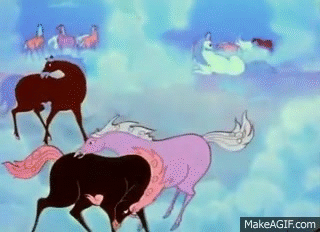
("Havok in Heaven" 1961)
Macaque, despite his foreboding aura, often ends up swarmed by younger/baby animals. He pretends not to know why. It's cause he has shameless mom instincts. Even if he was considered an Outsider to the original Monkey demon troop, he was adored by the infants he cared for. Those said infants are now grown immortal monkeys who see him as their many-times great-grandmother. If Sun Wukong is the honorary "Grandfather/Yeye/Waigong Sun" (as said in JttW) to all monkey demons, then Macaque is "Grandmother/Nainai/Zumu Liu'er". A similar effect occurs in rabbits (decendants of the wild moon rabbits he knew when he lived with Chang'e).

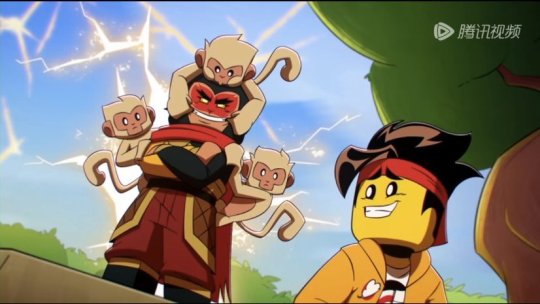
Sandy ofc loves cats and has similar Disney Princess-energy towards wild animals as seen in "To Catch a Leaf". Also tarantulas - you know why.
Pigsy claims to hate animals, but he folds if a cat or dog even headbutts him. Makes a million excuses why he doesnt run off the alley cats the hang out outside the restaurant. ("They're good for pest control.", "Leftovers gotta go somewhere.", "Tang you're petting one right now." Etc).
Tang loves animals like cats, but its a 50/50 if they'll even indulge him. I hc that he's a little scared of dogs and large birds (cicada instincts), but will pet a friendly good boi if they make a good first impression. Thinks pet bugs are really neat and underrated (Pigsy has banned him from getting any).
MK loves dogs. He is pure dog loving energy. Will look at an immortal celestial warhound and ask "Who's a good boy?" and he'll most likely get a tail wagging. Also thinks turtles are mega cool.
Mei I hc wasn't allowed pets in the Long/Dragon household, so she can be over-enthusiastic when meeting new critters, and gets sad when they scurry off startled. Wukong has been teaching her some of his old Bimawen tactics though, since she really loves horses (literal horse girl energy) and was def the little girl who asked for a pony every birthday.
Red Son is def a lizard/bird parent. I love the hc that his fave animals are chickens, and could def see him having a loose hen in the palace (wearing hygenic birdy pants ofc). He also seems like he'd vibe with desert/hot climate reptiles who see him as a heat lamp. Towards cattle and big farm animals tho? His territorial bull instincts flare up and starts picking fights.
Nezha likes snakes. Don't look too deep into it. (They remind him of Ao Bing). Thinks cats and dogs are overrated.
Bai He. Cats cats cats! She loves them in all their forms. Big, small, fluffy, sphinx! Like Mei she can be over-enthusiastic, and often gets scratched/bitten by street animals she tries to befriend. Big cats seem to like her for some reason.
+Bonus au character: Chenxiang loves birds. Especially water birds. They remind him of his very early childhood when ducks, geese, and crane would follow him and his mother while lotus harvesting. Will not stand for goose slander. Will get swarmed by flocks of birds if left alone in a public park.
#lego monkie kid#lmk#lmk hcs#the monkey king and the infant#the monkey king and the infant au#gif warning#sun wukong#liu er mihou#six eared macaque#qi xiaotian#lmk sandy#lmk pigsy#lmk tang#long xiaojiao#lmk mei#lmk red son#lmk nezha#lmk bai he#lmk lbd's host#lmk liu chenxiang#liu chenxiang#liu chen xiang
104 notes
·
View notes
Text

“Where’s Winter?” he whispered, nudging Ostrich with his elbow. She sat up and looked around with blurry confusion.
“I don’t know,” she said. “He was here a moment ago.”
Qibli twisted in a frantic circle and spotted a shadow flitting through the pear orchard. He couldn’t shout for Winter lest he alert the whole compound. Qibli groaned internally.
“Stay here,” he whispered to Ostrich. “Stay as hidden as you can. We’ll be right back.”
She nodded, strutting back into the shadows.
Qibli hurried after the Icewing prince and realized that he was aiming for the courtyard, separated from the orchard with a wall. It was enormous, surrounded with buildings and a partial bailey, blocking his view of the inside. The bricks were painted in a turquoise and amber mosaic of snakes and lizards chasing one another endlessly.
Before even seeing where Winter was headed, Qibli knew all too well what he was planning to do. The courtyard was noisy with birds and other pest-like creatures, alongside the distinct growl of a dragon.
Arrrrgh, Winter, you obsessed ninny.
He caught up as Winter was tinkering with the lock of the metal gate. It stretched up to an arch at the doorway, where the mud had begun to crumble, smelling of spoiled food, live pigs, and dates.
“Are you serious?” he said, and Winter jumped a mile, which was almost hilarious enough to make this side excursion worthwhile.
“Shhhhh!” Winter hissed.
“What are you thinking?” Qibli whispered.
“I’m thinking your horrifying grandfather will make this poor dragon into tomorrow’s buffet,” Winter whispered back. “Unless I save it.”
“Right now?” Qibli asked. “In the middle of our own precarious escape?”
“Well, I’m not planning on coming back!” Winter said, tugging on the lock again. “Hey, you’re a street thug. Can you pick this lock for me?”
“An Outclaw is not the same thing as a criminal,” Qibli protested. “Oh, fine, move over.” He studied the lock for a moment, unsheathing his kirpan and inserting it into the mechanism, wiggling it around until he heard a click.
“Now what?” he asked Winter as he nudged at the gate, careful not to open it too wide so the hinges wouldn’t creak. “We shove it in a bag and carry it off into the desert with us? I’m not sure if you’ve noticed this, but dragons aren’t exactly travel-sized.”
“We’ll just let it out,” Winter said, pacing past him into the moonlit quadrangle. “It’s smart enough to fend for itself after that.”
Qibli decided not to point out that it hadn’t been smart enough not to get caught in the first place.
Winter crouched beside a large chain, bound against the beige dragon’s hind leg and anchored into the ground with weights. Despite having thrashed helplessly a moment ago, this time it peered curiously down at them.
“Don’t be afraid,” Winter said softly. He looked around for the small alcohol lamp by the window they’d seen earlier, and carefully reached for its shackle. Upon bringing the flame close to the brass chains, the heat thawed through the metal like snow. They both stepped back and waited.
Slowly, the levitation-esque creature raised its head, tearing its obsidian black eyes from the two humans and towards the night sky. A plume of smoke shot through the air as it flapped its enormous wings once, then twice, then lifting itself off the ground, sending a whirlwind of sand flying into Qibli’s face, before swiftly gliding away to freedom.
#Sorry I CANNOT draw today#Wings of fire#Hwof#wings of fire au#wof au#Based off I think page 122-123 of darkness of dragons#I read a digital copy so that number might be off#wof qibli#wof ostrich#Wof winter#wof fanfic#sort of?#quotidianish
35 notes
·
View notes
Note
Thank you for you blog! I love it so much - I come here daily to read your latest posts.
I'd love to own a snake but alas, I currently live in New Zealand so no snakes for me.
Do you have cool facts about tuatara? I do but I'd love readers of your blog to learn about these cool little reptiles!
It's a huge dream of mine to work with tuatara one day! I've always loved the reptile life of Oceania and literally the only reason I haven't already moved to Australia or even Aotearoa/NZ is because of the limitations on keeping non-native species.
Anyway, aren't tuatara just the coolest? For those unfamiliar, tuatara (Sphenodon punctatus) might look like lizards, but they're not! Tuatara are the only surviving members of Rhynchocephalia, the sister order to Squamata, the scaled reptiles (lizards, snakes, and amphisbaenians).

Rhynchocephalians used to be very widespread, but today they exist only in limited populations in Aotearoa. They were almost driven to extinction by habitat loss and pressure from invasive species, and for a long time the only wild populations were on offshore islands. In a huge success for tuatara conservation, though, populations were reintroduced onto the North Island and there are now hatchlings being born on the North Island for the first time in centuries. There's still so much work to be done to help these amazing reptiles, but it's worth celebrating! The Chester Zoo in England has also welcomed tuatara hatchlings, meaning tuatara have been successfully bred outside of Aotearoa for the first time and indicating possible future success for wider zoo breeding programs across the world!
Tuatara have many anatomical features that are unique among reptiles, and they tell us a lot about the extinct rhynchocephalians. Their teeth arrangement is unique among reptiles, and their lower jaws can slide to cut through bone. They're the only known amniotes who have hourglass-shaped vertebrae, and they have gastralia (belly ribs). Even if they might look kinda like lizards on the outside, their skeleton is wildly different!

Tuatara have the most well-developed parietal eyes of any vertebrates. These are "third eyes" that sit on top of the head, and in most reptiles who have them they're extremely primitive, but in tuatara they have well-developed retinas and a cornea-like structure! Parietal eyes are covered by a thin layer of skin and probably help with thermoregulation and day/night cycle regulation.

They are carnivores and eat a wide diet of insects, lizards, and birds. Juvenile tuatara will hunt during the day so they can avoid being eaten themselves by adult tuatara, who hunt at night.
The name "tuatara" comes from te reo Māori, and means "peaks on the back," a reference to the spines along a tuatara's back. Tuatara are sexually dimorphic, and the spines are larger and more rigid in males. They're used in breeding and defensive displays!
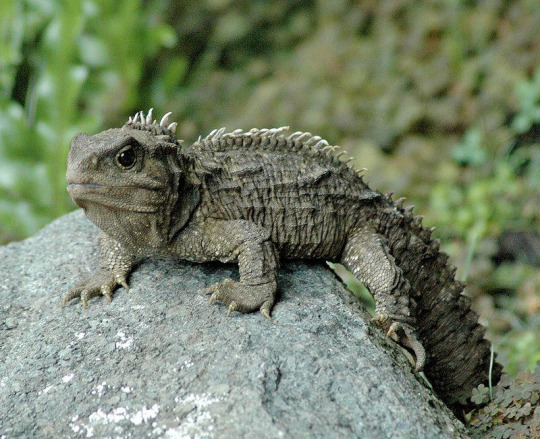
One of the challenges for tuatara conservation is how long it takes them to reach sexual maturity - about 10-20 years, and they tend to have very small egg clutches. They've been recorded to lay up to 19 eggs, but a more typical clutch is as small as 3-6 eggs or even a single egg. These eggs also take over a year to be laid and hatch. They have the slowest growth rates of any reptile, reaching full size at around 30 years and having an average lifespan of around 60 but lifespans closer to 100 not being uncommon.
The oldest known tuatara is named Henry, and he lives at the Invercargill museum on the South Island. He's at least 120 but may be as old as 150, and is still fathering healthy clutches!

Tuatara are simply incredible. They're so unique among living reptiles, and they have so much to tell us about a mostly-extinct order of reptiles. Plus, like, you can't deny they're so cool and adorable!
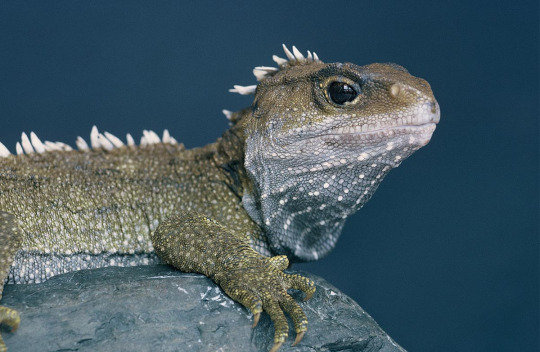
#not a rating#tuatara#tuatara anatomy#sorry for the long post. being asked to talk about tuatara awakens something within me#long post
363 notes
·
View notes
Text
Excerpt from this story from The Revelator:
Last summer I took advantage of my break from teaching by enjoying long, daily walks around my neighborhood. I indulged my mind and body in the blueness, stillness, and leafiness that is North Carolina in June and July. It’s truly astounding how many leaves a willow oak can cram into one tiny piece of sky.
On my walks, the yard of one house stuck out. It was unlike any yard I’ve seen around my city or in any of the other cities in the United States, Canada, and Australia where I’ve lived. It is a forest yard. Nearly a dozen large trees are interspersed amid a dense stand of saplings and shrubs. That summer, leaf litter covered the ground. The top of the house was only visible if I craned my neck to see down the paved driveway, itself narrowing and crumbling as roots, lichens, and fungi worked their inexorable magic.
Depending on your perspective, the house with the forest yard could be seen either as an eyesore — and the scariest place to trick-or-treat — or, as in my case, the most splendid place imaginable.
At this point, I should probably mention that I’m an urban ecologist and that the forest yard makes my heart flutter at the possibility and hope of nature in cities.
I looked at aerial images for the area, and they revealed that the trees around that home, which haven’t been actively “managed,” are about 50 years old. Over that time the forest yard has accumulated a bewildering array of species and ecological interactions. Its tulip poplars, walnuts, cedars, redbuds, pines, and willow oaks have soaked up the atmosphere’s carbon dioxide and turned it into much-needed habitat for wildlife: butterflies, bees, and other insects; lizards, snakes, and turtles; frogs and toads; birds; and mammals. It’s home to a multitude of soil invertebrates and fungi that keep the business side of an ecosystem — aka decomposition — going. All the species that share this shady third-of-an-acre lot are intertwined in a complex tangle of relationships that keeps them fed and feeding on one another, interdependent to varying degrees for their life and livelihood.
And all of this exists amidst a matrix of roads, single-family and multiplex housing, commercial plazas, light industry, and high rises that make up a medium-sized city in the Southeast. The forest yard is a little island of nature in a nearly lifeless sea of concrete, asphalt and lawn.
But, to my inexhaustible surprise, that sea of concrete, asphalt, and lawn is not as empty as we tend to assume. Very far from it. Places of dense human habitation are also where many species reside, including some that are threatened. A recent analysis of the birds and plants that occur in 147 cities across the globe revealed that the sampled cities were home to 2,041 bird species — about one-fifth of Earth’s total avian diversity — and 14,240 plant species. These include 36 bird and 65 plant species threatened with global extinction.
To get a better idea of just how much of the urban biodiversity iceberg lies below the surface of our awareness, consider this: Last year participants in the City Nature Challenge made nearly 1.9 million observations in 480 cities, with the residents of the La Paz metropolitan area in Bolivia recording the high score of 5,320 species.
Add to this the estimate that we share our homes and yards with an average of 9,000 species of fungi and bacteria and you’ll begin to suspect, as I do, that cities are in fact incredibly biodiverse. And it’s not just the all-too-rare forest yard: Scientific evidence shows that the more people you find in a place, the more types of birds, mammals, and plants you’ll find there too.
So why don’t we see it that way? Why do we perceive our urban centers as unworthy and undeserving of our conservation efforts and attention?
18 notes
·
View notes
Note
Hello! Why did penguins evolve to have black feathers if they live in icy (mostly white?) locations? I understand them having a white tummy because when swimming they could be more difficult to identify by a predator swimming below them? Thanks!
Love your blog!
Hello! So, here's what I learned at uni:
the widely-accepted reason penguins have black feathers is the same reason they have white tummies, but backwards. When swimming, they are more difficult to identify by a predator swimming above them! You can see similar countershading in sharks and dolphins, and also on land animals like mountain goats and lizards. Overall, it helps to make animals less obvious when viewing from the side, because it reduces the obviousness of their shadow.

As to why penguins have black feathers in icy, mostly white, locations (on LAND), you need to consider why it would be good to be white in an icy, white location in the first place!
Mostly, it would provide camouflage, which would protect from land predators! However, penguins don't really have any significant land predators in Antarctica. There are no polar bears, or big snakes, or even foxes or coyotes in Antarctica, so the penguin won't benefit from being camouflaged on land. Basically, there's no "selective pressure" for them to be all white!
some penguin chicks, however, do have to worry about a few predators, so they have a little more camouflage than the adult penguins:

What's more, there are likely advantages to black feathers in a cold environment like Antarctica! For example, in the sun, dark feathers absorb more thermal energy, helping to warm the penguin and maintain their body heat.
There may also be some stuff with black feathers being more resistant to wear/ friction drag in the water, but that's entering the realm of ongoing research, which I won't get into here.
Let me know if there's anything that needs clarifying!
(some citations if anyone wants further reading:)
Bonser, R. H. (1995). Melanin and the abrasion resistance of feathers. The Condor, 97(2), 590-591.
Ksepka, D. T. (2016). The penguin's palette--more than black and white: this stereotypically tuxedo-clad bird shows that evolution certainly can accessorize. American Scientist, 104(1), 36-44.
Rowland, H. M. (2009). From Abbott Thayer to the present day: what have we learned about the function of countershading?. Philosophical Transactions of the Royal Society B: Biological Sciences, 364(1516), 519-527.
Zagrai, A., & Hassanalian, M. (2020, July). Penguin coloration affects skin friction drag. In 2020 Gulf Southwest Section Conference.
182 notes
·
View notes
Note
You know, the idea of the kwami's true forms being mythical creatures is actually a really cool and clever idea.
It's one that makes the most sense. Across various cultures, everyone has mythology relating to animals. Some range from common animal but it's big, like Fenrir is a big wolf.
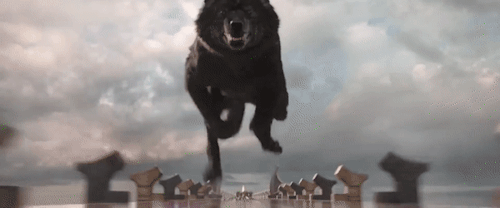
Others are same animal but there's something mystical about it. Like the phoenix is usually portrayed as an eagle but it's also been vague bird that's fiery and is always reborn through flames. Unicorn and Pegasus are horse but with horn and wings respectively (though some unicorns do have hooves of goat and at ail of a lion). Or the kitsune which is a fox but has many tails, and there's the Finnish firefox that create the Aurora Borealis.
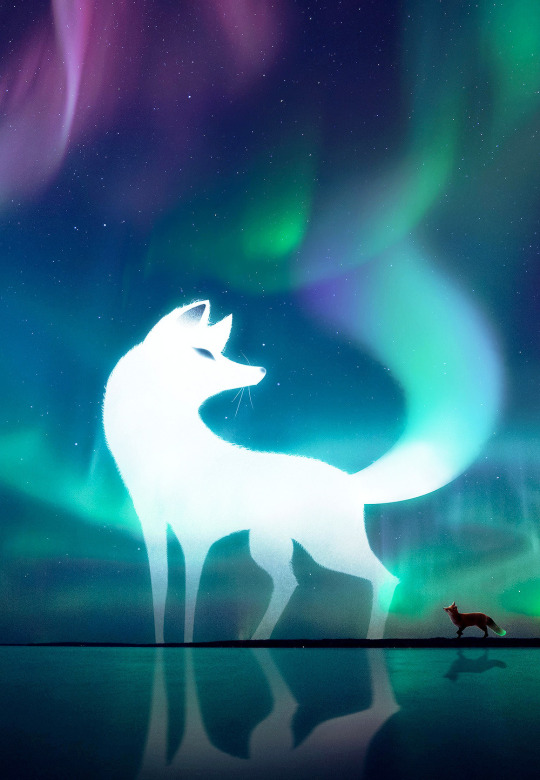
While others are a mix of various animals. Iconic dragons often boil down to snake/lizard with bat wings. And it happens to be tied to elemental power.
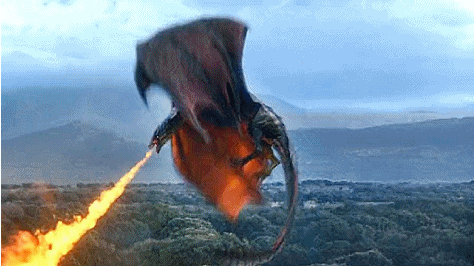
And this idea can play into creative flexibility for kwamis and their origins. Cause I don't know how canon the comics are or if they even should be counted as canon, I know a lot accept it as so as that's the only origins on kwamis and Miraculous thus far; but if people are up for more creative/different origins, you could do that kwamis did exist as mythical creatures. Playing into the idea that humans were endangered by what was magical and magic was rare for them, one of the best ways to combat magic is with magic. East to west, often a lot of stories about combating a magical threat is to have something or someone magical too.
It could be a mage or mages approached these fantastical creatures and offered them a deal: immortality and power for servitude and assistance of humanity. Cause Miraculous are meant to be used for good, and Origins implies it was against threats that humanity couldn't face as they were.

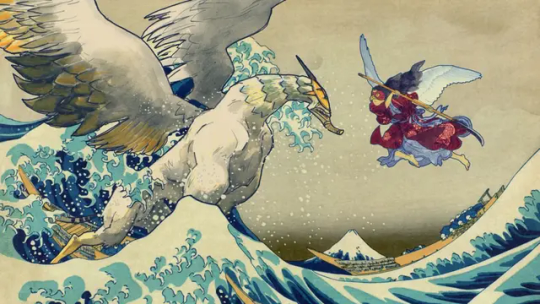
So kwamis existing not as cosmic beings but actual powerful creatures that lived on earth for eons and accepted the offer for immortality and power for servitude, can work well. And they take on a more "humble" form, not just as these little beings that you can easily carry around and hide in public as needed, but also could back them appearing as common animals. And this way, if kwamis really let their power lose, you're shaken seeing some big kaiju/mythical creature ready to let it all lose.
It could work off kwamis being all over the place morally or how they interact with humans. Some eagerly accepted because they wanted that immortality and power, some wanted to genuinely help humans, and some could've been tricked and thus would slower to warm up to humans.
Only thing is that this may not roll well with kwamis being embodiment of concepts, though arguably that could be for the better.
#ask Punchie#kwamis#miraculous changes#miraculous lore#another aspect that clashes is Longg's existence#unless you count the NA Miraculous existing#Draogn's a bit of an eyesore as a Miraculous#with this Longg shouldn't exist as a mythical creature but be something more humble#I think the ONLY way you could make Longg work in this set up#is reveal that Longg was the legendary carp that jumped the Dragon's Gate#and Longg agreed to be bound to a Miraculous#but buddies#she worked SO HARD to become a dragon#she's not giving that up#and the mage(s) compromised and let her keep her draconic form#and she's a true (sea)dragon
31 notes
·
View notes